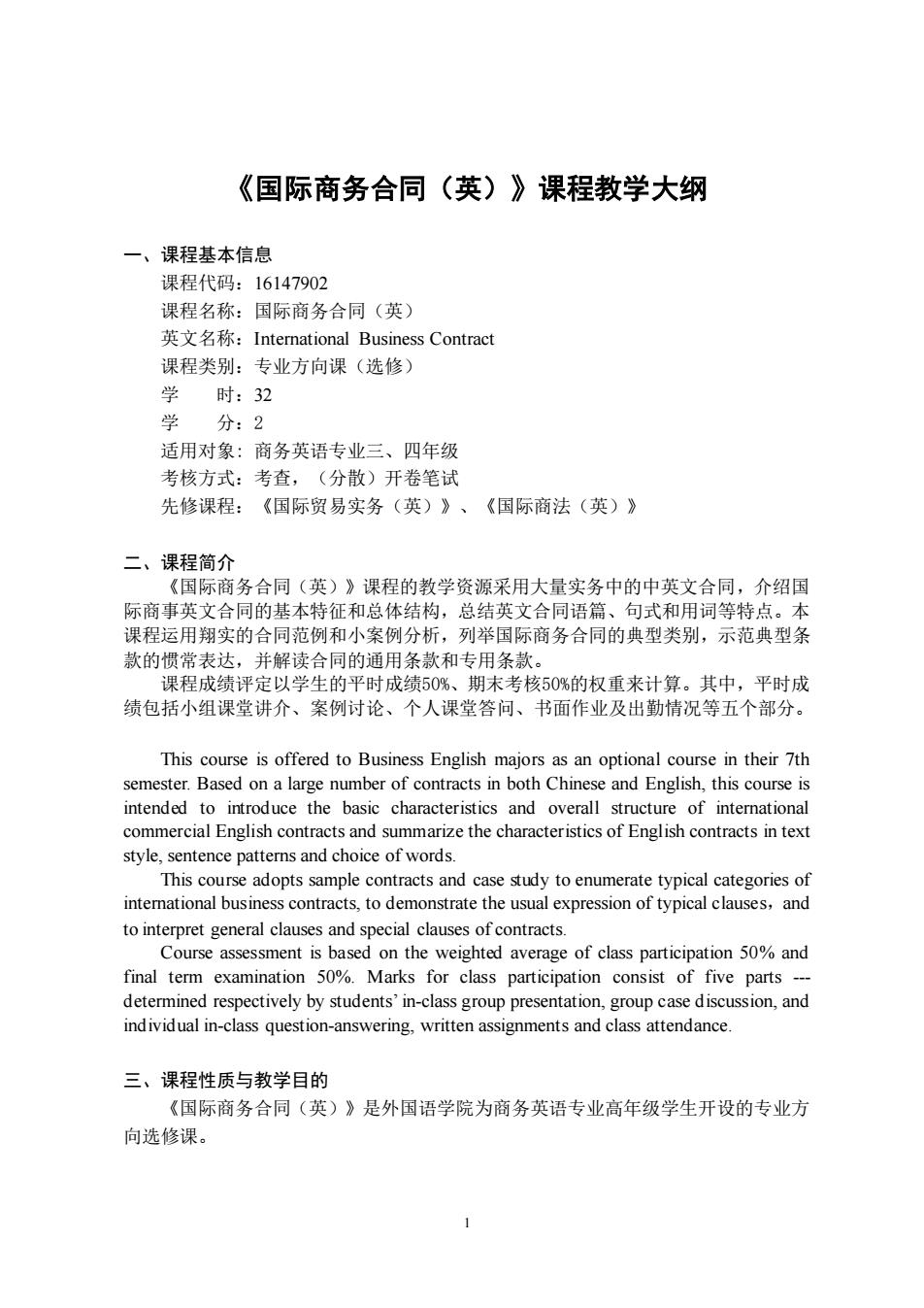
《国际商务合同(英)》课程教学大纲 一、课程基本信息 课程代码:16147902 课程名称:国际商务合同(英) 英文名称:Interational Business Contract 课程类别:专业方向课(选修) 学 时:32 学 分:2 适用对象:商务英语专业三、四年级 考核方式:考查,(分散)开卷笔试 先修课程:《国际贸易实务(英)》、 《国际商法(英)》 二、课程简介 《国际商务合同(英)》课程的教学资源采用大量实务中的中英文合同,介绍国 际商事英文合同的基本特征和总体结构,总结英文合同语篇、句式和用词等特点。本 课程运用翔实的合同范例和小案例分析,列举国际商务合同的典型类别,示范典型条 款的惯常表达 并解读合同的通用条款和专用条款 评定以学生 平时成绩50 期末考核50%的权重来计算 。其中,平时成 绩包括小组课堂讲介、案例讨论、个人课堂答问、书面作业及出勤情况等五个部分。 This course is offered to Business English maj an optional course in their 7th semest intended to introduce the basic characteristics and overall structure of international commercial English contracts and summarize the characteristics of English contracts in text style,sentence patterns and choice of words. This course adopts sample contracts and case study to enumerate typical categories of intemational business contracts,to demonstrate the usual expression of typical clauses,and to interpret general clauses and special clauses of contracts. Course assessment is based on the weighted average of class participation 50%and final term examination 50%.Marks for class participation consist of five parts- determined respectively by students'in-class group presentation,group case discussion,and individual in-class question-answering,written as nents and class attendance 三、课程性质与教学目的 《国际商务合同(英)》是外国语学院为商务英语专业高年级学生开设的专业方 向选修课
1 《国际商务合同(英)》课程教学大纲 一、课程基本信息 课程代码:16147902 课程名称:国际商务合同(英) 英文名称:International Business Contract 课程类别:专业方向课(选修) 学 时:32 学 分:2 适用对象: 商务英语专业三、四年级 考核方式:考查,(分散)开卷笔试 先修课程:《国际贸易实务(英)》、《国际商法(英)》 二、课程简介 《国际商务合同(英)》课程的教学资源采用大量实务中的中英文合同,介绍国 际商事英文合同的基本特征和总体结构,总结英文合同语篇、句式和用词等特点。本 课程运用翔实的合同范例和小案例分析,列举国际商务合同的典型类别,示范典型条 款的惯常表达,并解读合同的通用条款和专用条款。 课程成绩评定以学生的平时成绩50%、期末考核50%的权重来计算。其中,平时成 绩包括小组课堂讲介、案例讨论、个人课堂答问、书面作业及出勤情况等五个部分。 This course is offered to Business English majors as an optional course in their 7th semester. Based on a large number of contracts in both Chinese and English, this course is intended to introduce the basic characteristics and overall structure of international commercial English contracts and summarize the characteristics of English contracts in text style, sentence patterns and choice of words. This course adopts sample contracts and case study to enumerate typical categories of international business contracts, to demonstrate the usual expression of typical clauses,and to interpret general clauses and special clauses of contracts. Course assessment is based on the weighted average of class participation 50% and final term examination 50%. Marks for class participation consist of five parts --- determined respectively by students’ in-class group presentation, group case discussion, and individual in-class question-answering, written assignments and class attendance. 三、课程性质与教学目的 《国际商务合同(英)》是外国语学院为商务英语专业高年级学生开设的专业方 向选修课
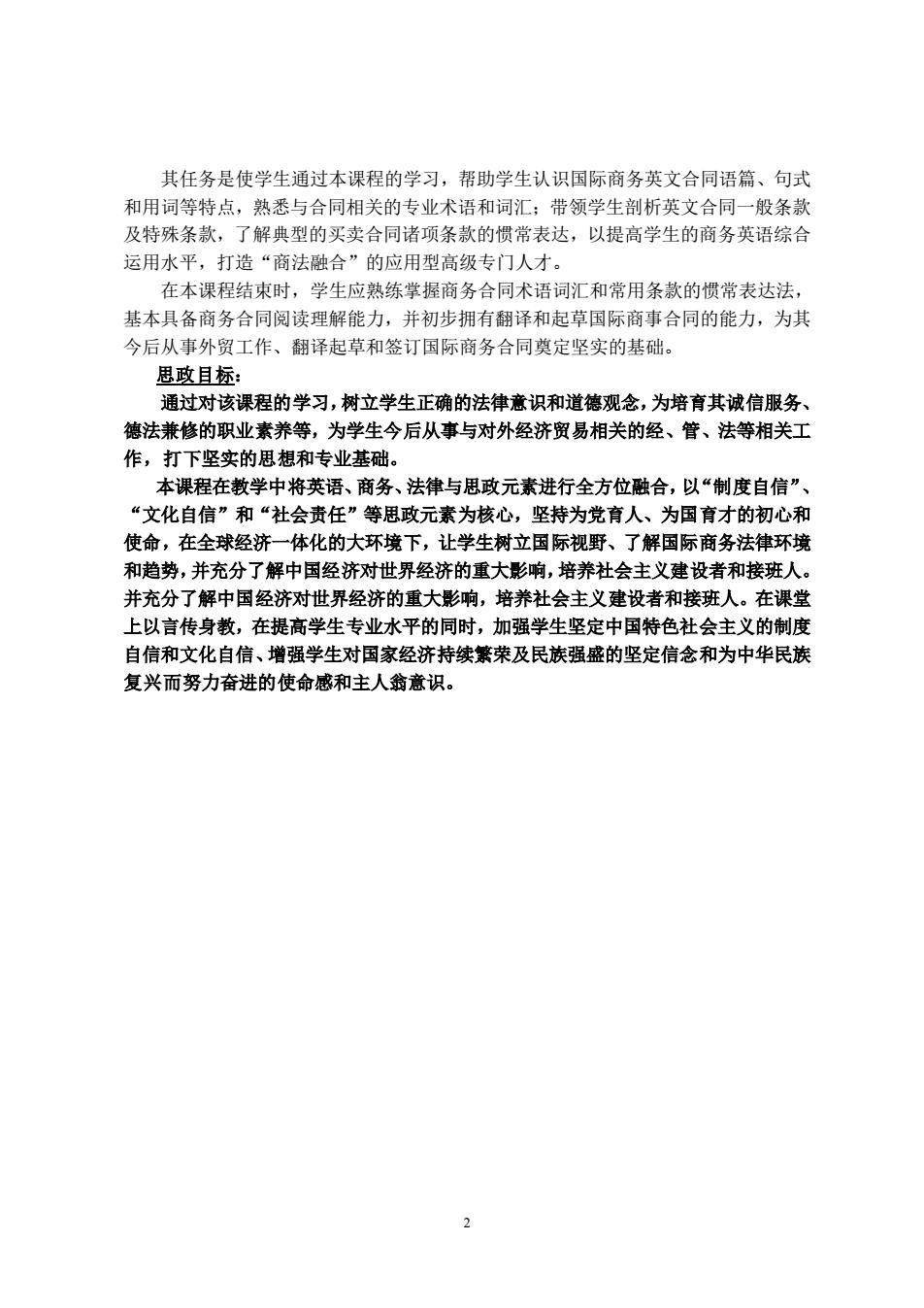
其任务是使学生通过本课程的学习,帮助学生认识国际商务英文合同语篇、句式 和用词等特点,熟悉与合同相关的专业术语和词汇;带领学生剖析英文合同一般条款 及特殊条款,了解典型的买卖合同诸项条款的惯常表达,以提高学生的商务英语综合 运用水平,打造“商法融合”的应用型高级专门人才。 在本课程结束时,学生应熟练掌握商务合同术语词汇和常用条款的惯常表达法, 基本具备商务合同阅读理解能力,并初步拥有翻译和起草国际商事合同的能力,为其 今后从事外贸工作、翻译起草和签订国际商务合同奠定坚实的基础。 思政目标: 通过对该课程的学习,树立学生正确的法律意识和道德观念,为培育其诚信服务 德法兼修的职业素养等,为学生今后从事与对外经济贸易相关的经、管、法等相关工 作,打下坚实的思想和专业基础。 本课程在教学中将英语、商务、法律与思政元素进行全方位融合,以“制度自信”、 “文化自信”和“社会责任”等思政元素为核心,坚持为党育人、为国育才的初心和 使命,在全球经济一体化的大环境下,让学生树立国际视野、了解国际商务法律环境 和趋势,并充分了解中国经济对世界经济的重大影响,培养社会主义建设者和接班人 并充分了解中国经济对世界经济的重大影响,培养社会主义建设者和接班人。在课堂 上以言传身教,在提高学生专业水平的同时,加强学生坚定中国特色社会主义的制度 自信和文化自信、增强学生对国家经济持续繁荣及民族强盛的坚定信念和为中华民族 复兴而努力奋进的使命感和主人翁意识: 2
2 其任务是使学生通过本课程的学习,帮助学生认识国际商务英文合同语篇、句式 和用词等特点,熟悉与合同相关的专业术语和词汇;带领学生剖析英文合同一般条款 及特殊条款,了解典型的买卖合同诸项条款的惯常表达,以提高学生的商务英语综合 运用水平,打造“商法融合”的应用型高级专门人才。 在本课程结束时,学生应熟练掌握商务合同术语词汇和常用条款的惯常表达法, 基本具备商务合同阅读理解能力,并初步拥有翻译和起草国际商事合同的能力,为其 今后从事外贸工作、翻译起草和签订国际商务合同奠定坚实的基础。 思政目标: 通过对该课程的学习,树立学生正确的法律意识和道德观念,为培育其诚信服务、 德法兼修的职业素养等,为学生今后从事与对外经济贸易相关的经、管、法等相关工 作,打下坚实的思想和专业基础。 本课程在教学中将英语、商务、法律与思政元素进行全方位融合,以“制度自信”、 “文化自信”和“社会责任”等思政元素为核心,坚持为党育人、为国育才的初心和 使命,在全球经济一体化的大环境下,让学生树立国际视野、了解国际商务法律环境 和趋势,并充分了解中国经济对世界经济的重大影响,培养社会主义建设者和接班人。 并充分了解中国经济对世界经济的重大影响,培养社会主义建设者和接班人。在课堂 上以言传身教,在提高学生专业水平的同时,加强学生坚定中国特色社会主义的制度 自信和文化自信、增强学生对国家经济持续繁荣及民族强盛的坚定信念和为中华民族 复兴而努力奋进的使命感和主人翁意识
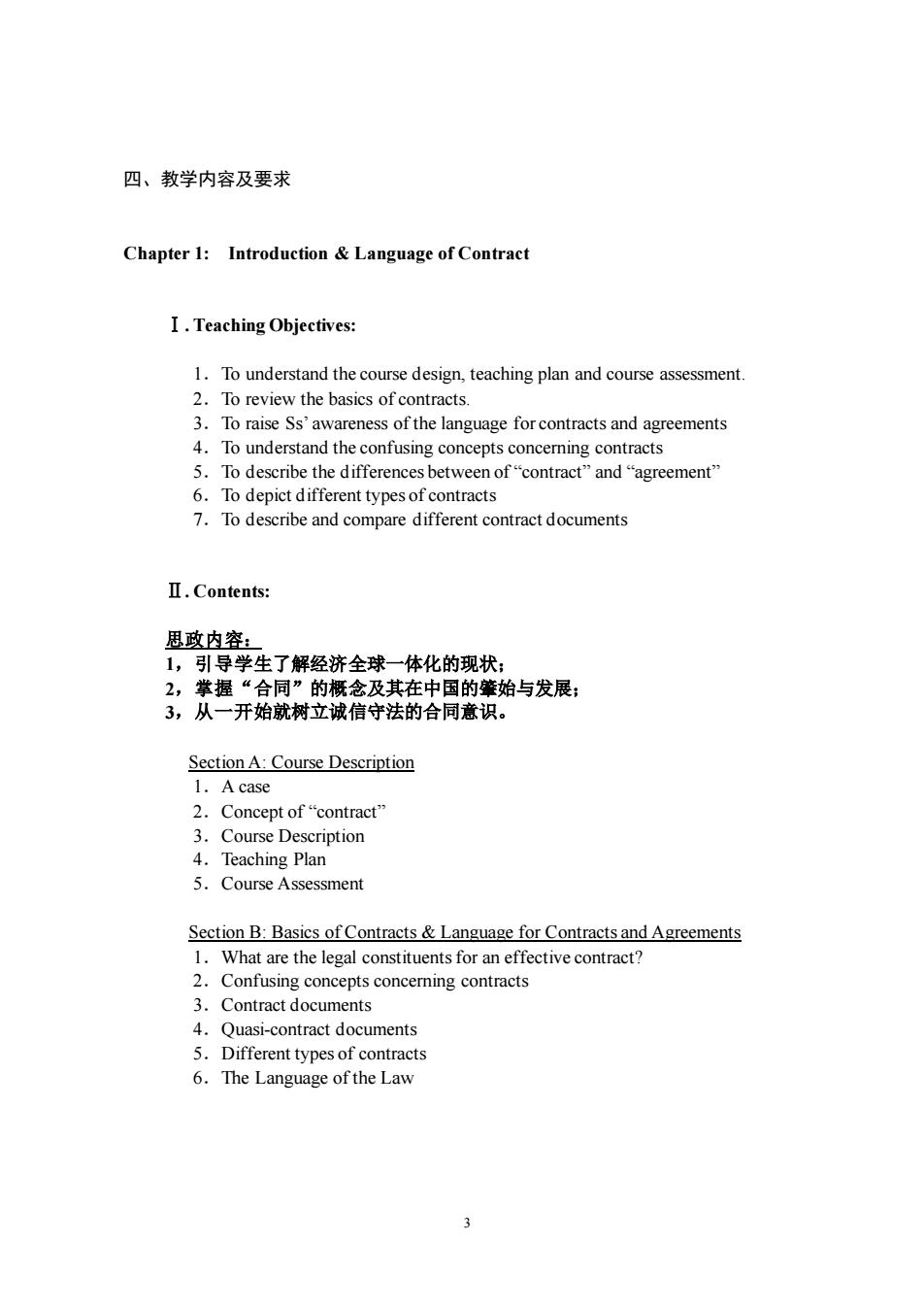
四、教学内容及要求 Chapter 1:Introduction Language of Contract I.Teaching Objectives: 1.To understand the course design,teaching plan and course assessment 2.To review the basics of contracts. 3.To raise Ss'awareness ofthe language for contracts and agreements 4.To understand the confusing concepts concerning contracts 5. To des etwee Todepiddferent5ypesofconiacts "and"agreement 7.To describe and compare different contract documents II.Contents: 恩政内容 1,引导学生了解经济全球 一体化的现状: 2,掌握“合同”的概念及其在中国的肇始与发展: 3,从一开始就树立诚信守法的合同意识。 Section A:Course Description 1.A case 2.Concept of"contract" 3.Course Description 4.Teaching Plan 5.Course Assessment Section B:Basics of Contracts&Language for Contracts and Agreements 1.What are the legal constituents for an effective contract? 2.Confusing conceptsconcemingcontracts 34 Contract documents Quasi-contract documents 5.Different types of contracts 6.The Language of the Law 3
3 四、教学内容及要求 Chapter 1: Introduction & Language of Contract Ⅰ. Teaching Objectives: 1.To understand the course design, teaching plan and course assessment. 2.To review the basics of contracts. 3.To raise Ss’ awareness of the language for contracts and agreements 4.To understand the confusing concepts concerning contracts 5.To describe the differences between of “contract” and “agreement” 6.To depict different types of contracts 7.To describe and compare different contract documents Ⅱ. Contents: 思政内容: 1,引导学生了解经济全球一体化的现状; 2,掌握“合同”的概念及其在中国的肇始与发展; 3,从一开始就树立诚信守法的合同意识。 Section A: Course Description 1.A case 2.Concept of “contract” 3.Course Description 4.Teaching Plan 5.Course Assessment Section B: Basics of Contracts & Language for Contracts and Agreements 1.What are the legal constituentsfor an effective contract? 2.Confusing concepts concerning contracts 3.Contract documents 4.Quasi-contract documents 5.Different types of contracts 6.The Language of the Law
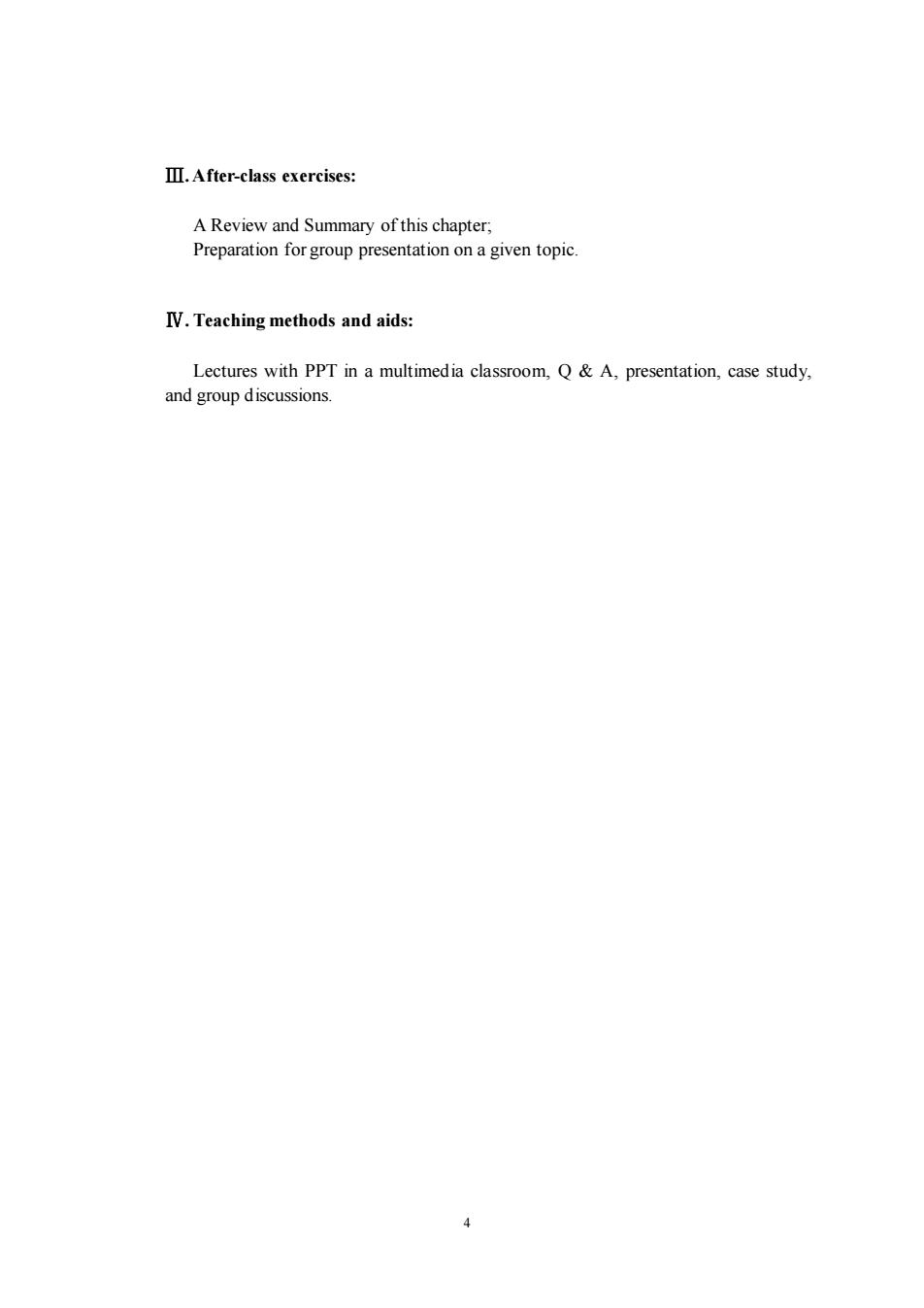
III.After-class exercises: A Review and Summary of this chapter. Preparation for group presentation on a given topic I.Teaching methods and aids: Lectures with PPT in a multimedia classroom,Q&A,presentation,case study. and group discussions
4 Ⅲ.After-class exercises: A Review and Summary of this chapter; Preparation for group presentation on a given topic. Ⅳ. Teaching methods and aids: Lectures with PPT in a multimedia classroom, Q & A, presentation, case study, and group discussions
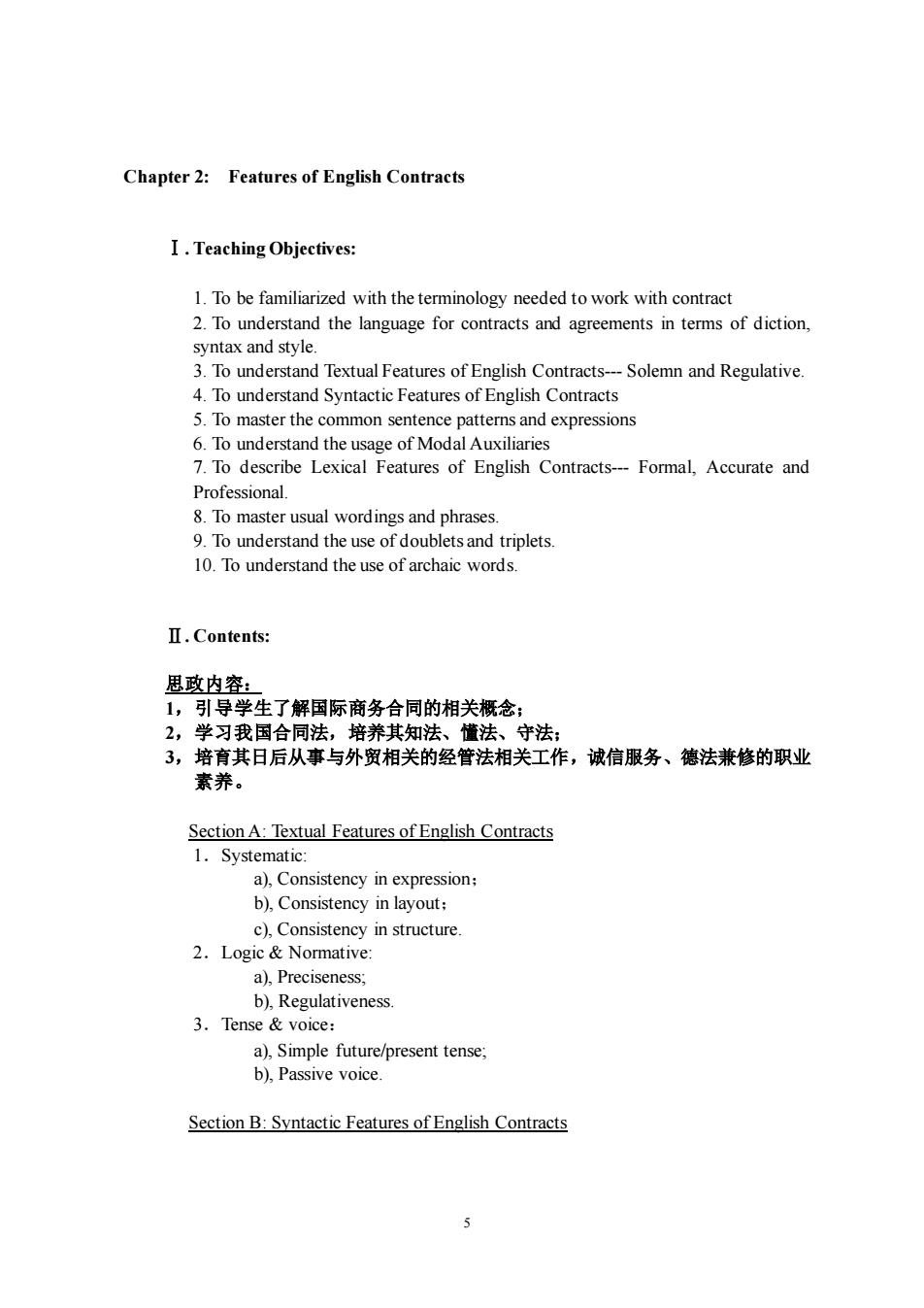
Chapter 2:Features of English Contracts I.Teaching Objectives: 1.To be familiarized with the terminology needed to work with contract 2.To understand the language for contracts and agreements in terms of diction, syntax and style. 3.To understand Textual Features of English Contracts--Solemn and Regulative 4.To understand Syntactic Features of English Contracts S To master the common sentence patters and expressions 6.To understand the usage of modal auxiliaries 7.To describe Lexical Features of English Contracts---Formal,Accurate and Professional ter usual wording and nrase 10.To understand the use of archaic words. II.Contents: 思政内容 1,引导学生了解国际商务合同的相关概念 2,学习我国合同法,培养其知法、懂法、守法: 3,培育其日后从事与外贸相关的经管法相关工作,诚信服务、德法兼修的职业 素养。 SectionA:Textual Features of English Contracts 1.Systematic: a).Consistency in expression: b),Consistency in layout: c),Consistency in structure 2.Logic Normative: a).Preciseness: b).Regulativeness 3.Tense voice: a),Simple future/present tense b),Passive voice Section B:Syntactic Features of English Contracts 5
5 Chapter 2: Features of English Contracts Ⅰ. Teaching Objectives: 1. To be familiarized with the terminology needed to work with contract 2. To understand the language for contracts and agreements in terms of diction, syntax and style. 3. To understand Textual Features of English Contracts--- Solemn and Regulative. 4. To understand Syntactic Features of English Contracts 5. To master the common sentence patterns and expressions 6. To understand the usage of Modal Auxiliaries 7. To describe Lexical Features of English Contracts--- Formal, Accurate and Professional. 8. To master usual wordings and phrases. 9. To understand the use of doublets and triplets. 10. To understand the use of archaic words. Ⅱ. Contents: 思政内容: 1,引导学生了解国际商务合同的相关概念; 2,学习我国合同法,培养其知法、懂法、守法; 3,培育其日后从事与外贸相关的经管法相关工作,诚信服务、德法兼修的职业 素养。 Section A: Textual Features of English Contracts 1.Systematic: a), Consistency in expression; b), Consistency in layout; c), Consistency in structure. 2.Logic & Normative: a), Preciseness; b), Regulativeness. 3.Tense & voice: a), Simple future/present tense; b), Passive voice. Section B: Syntactic Features of English Contracts
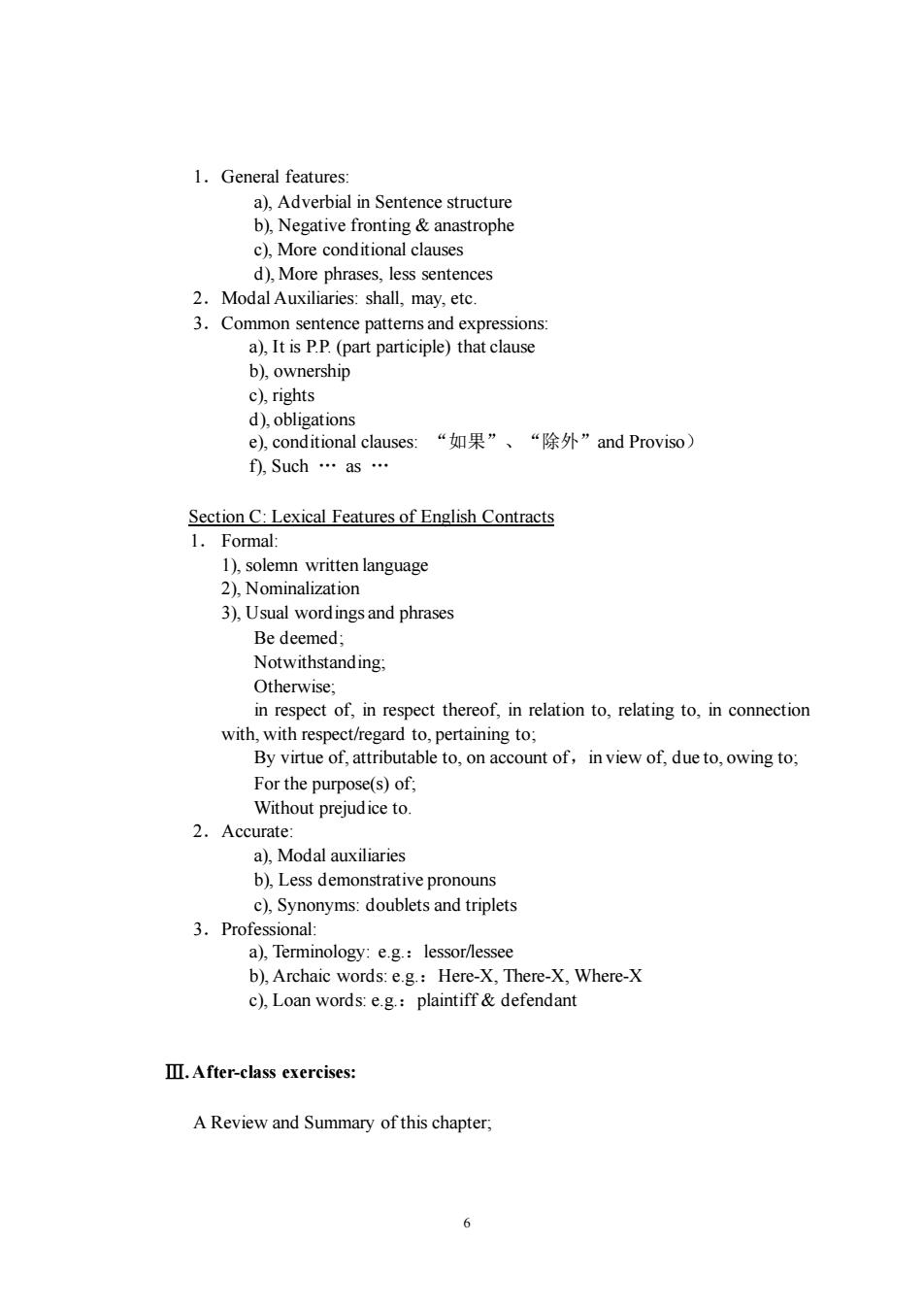
1.General features: a).adverbial in sentence structure c以 e c al clauses d).More phrases,less sentences 2.Modal Auxiliaries:shall,may,etc. 3.Common sentence pattems and expressions a).It is P.P.(part participle)that clause b). c以rights d),obligations e).conditional clauses: “如果”、“除外”and Proviso) f.Such·as… Section C:Lexical Features of English Contracts 1.Formal: 1),solemn written language 2)Nominalization 3).Usual wordings and phrases Be deemed; Notwithstanding: Otherwise: in respect of,in respect thereof,in relation to,relating to,in connection with,with respect/regard to,pertaining to: By virtue of,attributable to,on account of,in view of,due to,owing to. For the purpose(s)of: Without prejud ice to. 2.Accurate: a).Modal auxiliaries b).Less demonstrative pronouns ),Synonyms:doublets and triplet 3.Professional a),Terminology:e.g.:lessor/lessee b),Archaic words:e.g.:Here-X,There-X,Where-X c).Loan words:e.g.:plaintiff defendant III.After-class exercises: a review and summary of this chapter 6
6 1.General features: a), Adverbial in Sentence structure b), Negative fronting & anastrophe c), More conditional clauses d), More phrases, less sentences 2.Modal Auxiliaries: shall, may, etc. 3.Common sentence patterns and expressions: a), It is P.P. (part participle) that clause b), ownership c), rights d), obligations e), conditional clauses: “如果”、“除外”and Proviso) f), Such … as … Section C: Lexical Features of English Contracts 1. Formal: 1), solemn written language 2), Nominalization 3), Usual wordings and phrases Be deemed; Notwithstanding; Otherwise; in respect of, in respect thereof, in relation to, relating to, in connection with, with respect/regard to, pertaining to; By virtue of, attributable to, on account of,in view of, due to, owing to; For the purpose(s) of; Without prejudice to. 2.Accurate: a), Modal auxiliaries b), Less demonstrative pronouns c), Synonyms: doublets and triplets 3.Professional: a), Terminology: e.g.:lessor/lessee b), Archaic words: e.g.:Here-X, There-X, Where-X c), Loan words: e.g.:plaintiff & defendant Ⅲ.After-class exercises: A Review and Summary of this chapter;
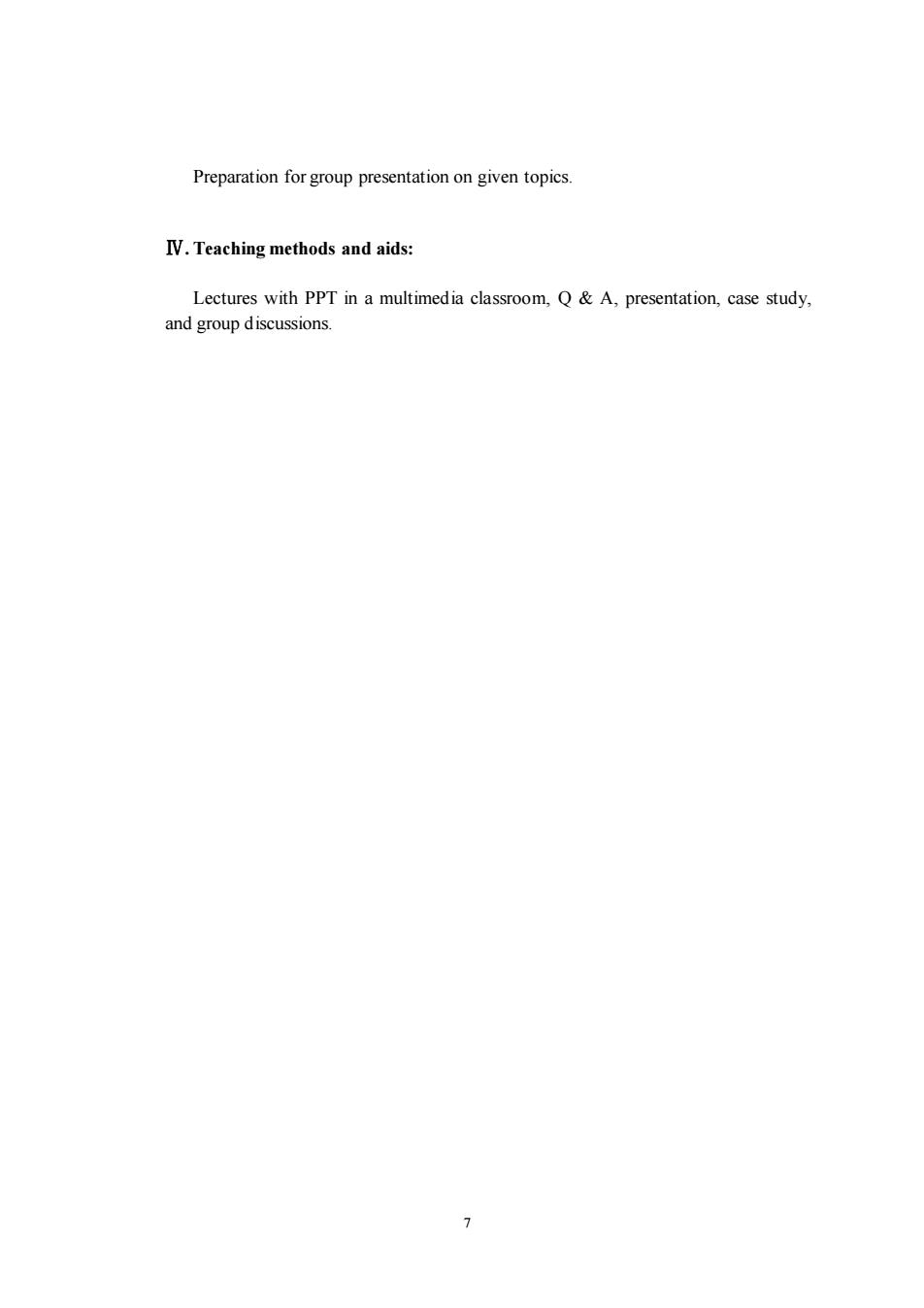
Preparation for group presentation on given topics. IV.Teaching methods and aids: Lectures with PPT in a multimedia classroom,Q&A,presentation,case study, and group discussions
7 Preparation for group presentation on given topics. Ⅳ. Teaching methods and aids: Lectures with PPT in a multimedia classroom, Q & A, presentation, case study, and group discussions
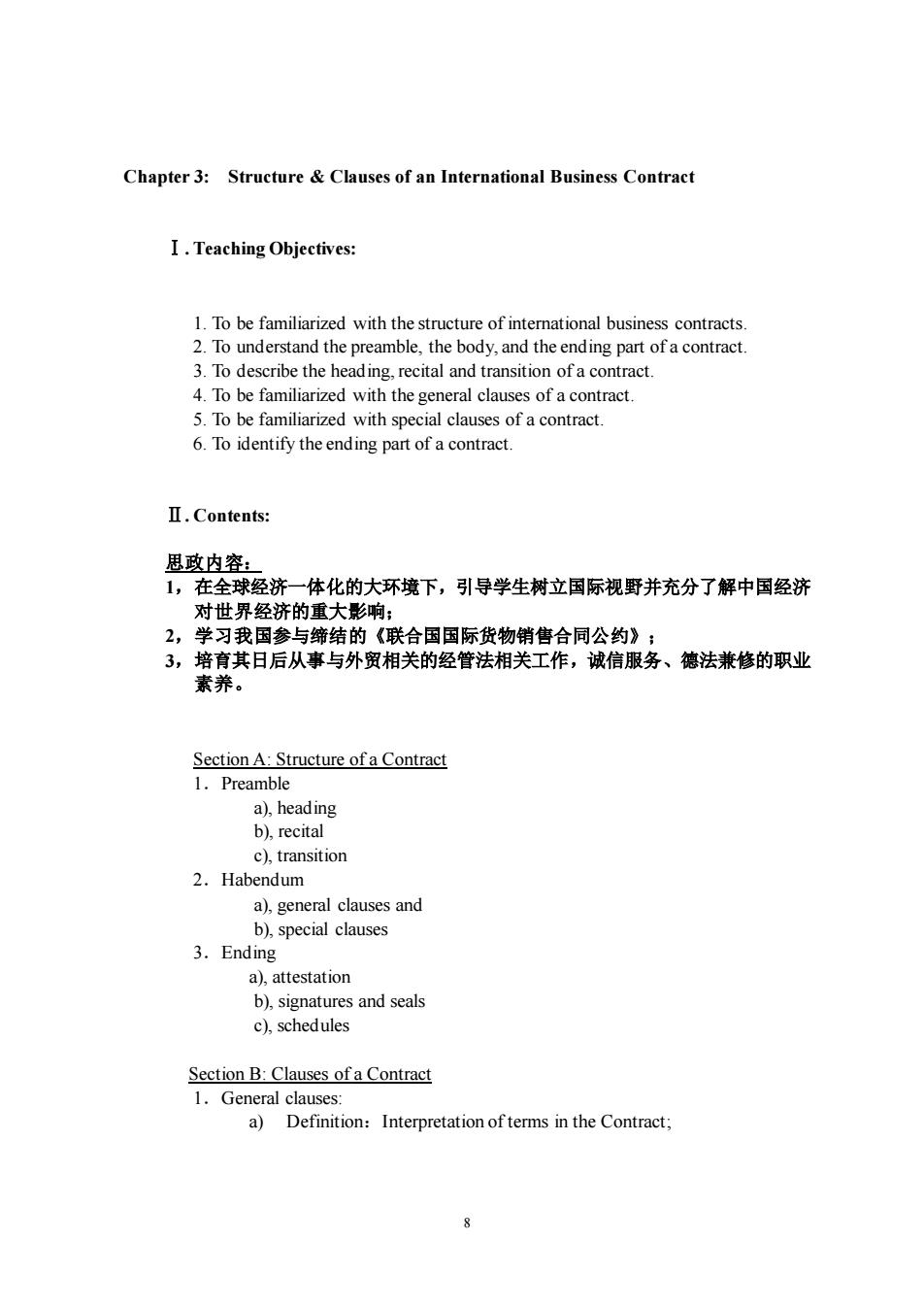
Chapter 3:Structure Clauses of an International Business Contract I.Teaching Objectives: 1.To be familiarized with the structure of international business contracts. 2.To understand the preamble,the body,and the ending part ofa contract. 3.To d scribe the head recital and ansition of a con 5.To be familiarized with special clauses of a contract. 6.To identify the ending part of a contract. II.Contents: 思政内容: 1,在全球经济一体化的大环境下,引导学生树立国际视野并充分了解中国经济 对世界经济的重大影响: 2,学习我国参与缔结的《联合国国际货物销售合同公约》; 3, 培育其日后从事与外贸相关的经管法相关工作,诚信服务、德法兼修的职业 Section A:Structure ofa Contract 1.Preamble a),heading b).recital c).transition 2.Habendum a),general clauses and b),special clauses 3.Ending a),attestation b),signatures and seals c),schedules Section B:Clauses ofa Contract 1.General clauses: a)Definition:Interpretation ofterms in the Contract: 8
8 Chapter 3: Structure & Clauses of an International Business Contract Ⅰ. Teaching Objectives: 1. To be familiarized with the structure of international business contracts. 2. To understand the preamble, the body, and the ending part of a contract. 3. To describe the heading, recital and transition of a contract. 4. To be familiarized with the general clauses of a contract. 5. To be familiarized with special clauses of a contract. 6. To identify the ending part of a contract. Ⅱ. Contents: 思政内容: 1,在全球经济一体化的大环境下,引导学生树立国际视野并充分了解中国经济 对世界经济的重大影响; 2,学习我国参与缔结的《联合国国际货物销售合同公约》; 3,培育其日后从事与外贸相关的经管法相关工作,诚信服务、德法兼修的职业 素养。 Section A: Structure of a Contract 1.Preamble a), heading b), recital c), transition 2.Habendum a), general clauses and b), special clauses 3.Ending a), attestation b), signatures and seals c), schedules Section B: Clauses of a Contract 1.General clauses: a) Definition:Interpretation of terms in the Contract;
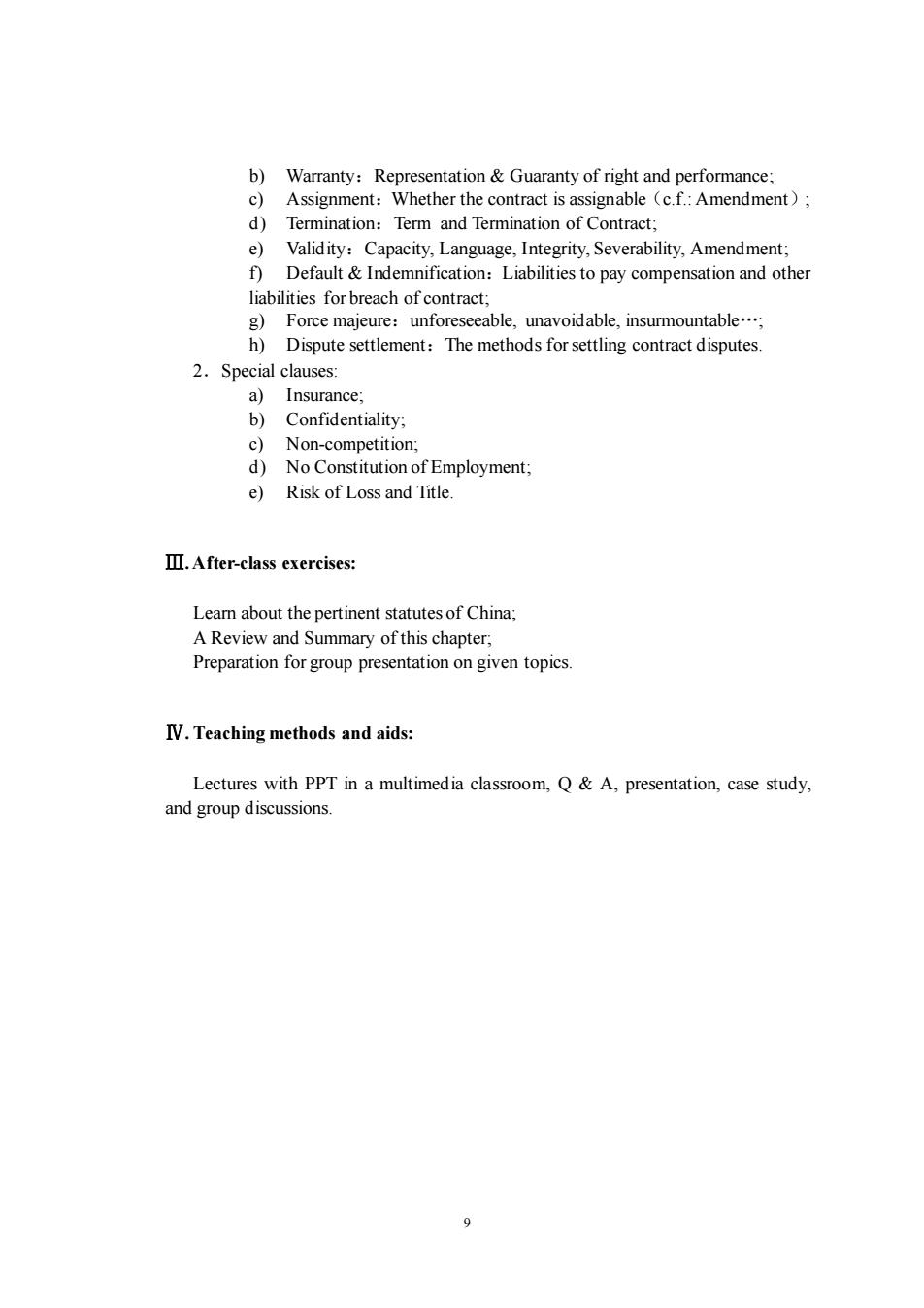
b) Warranty:Representation&Guaranty of right and performance; c) Assignment:Whether the contract is assignable(c.f.:Amendment); d)Termination:Term and Termination of Contract )Validity:Capacity,Language,Integrity,Severability,Amendment: 0 Default&Indemnification Liabilities to pay compensation and othe liabilities for breach of contract; g)Force majeure:unforeseeable.unavoidable.insurmountable. h)Dispute settlement:The methods for settling contract disputes. 2.Special clauses: Insurance b) Confidentiality: Non-competition; d)No Constitution of Employment: e)Risk of Loss and Title. II.After-class exercises: Leam about the pertinent statutes of China: A Review and Summary of this chapter Preparation for group presentation on given topics IV.Teaching methods and aids: Lectures with PPT in a multimedia classroom,Q&A,presentation,case study and group discussions
9 b) Warranty:Representation & Guaranty of right and performance; c) Assignment:Whether the contract is assignable(c.f.: Amendment); d) Termination:Term and Termination of Contract; e) Validity:Capacity, Language, Integrity, Severability, Amendment; f) Default & Indemnification:Liabilities to pay compensation and other liabilities for breach of contract; g) Force majeure:unforeseeable, unavoidable, insurmountable…; h) Dispute settlement:The methods for settling contract disputes. 2.Special clauses: a) Insurance; b) Confidentiality; c) Non-competition; d) No Constitution of Employment; e) Risk of Loss and Title. Ⅲ.After-class exercises: Learn about the pertinent statutes of China; A Review and Summary of this chapter; Preparation for group presentation on given topics. Ⅳ. Teaching methods and aids: Lectures with PPT in a multimedia classroom, Q & A, presentation, case study, and group discussions
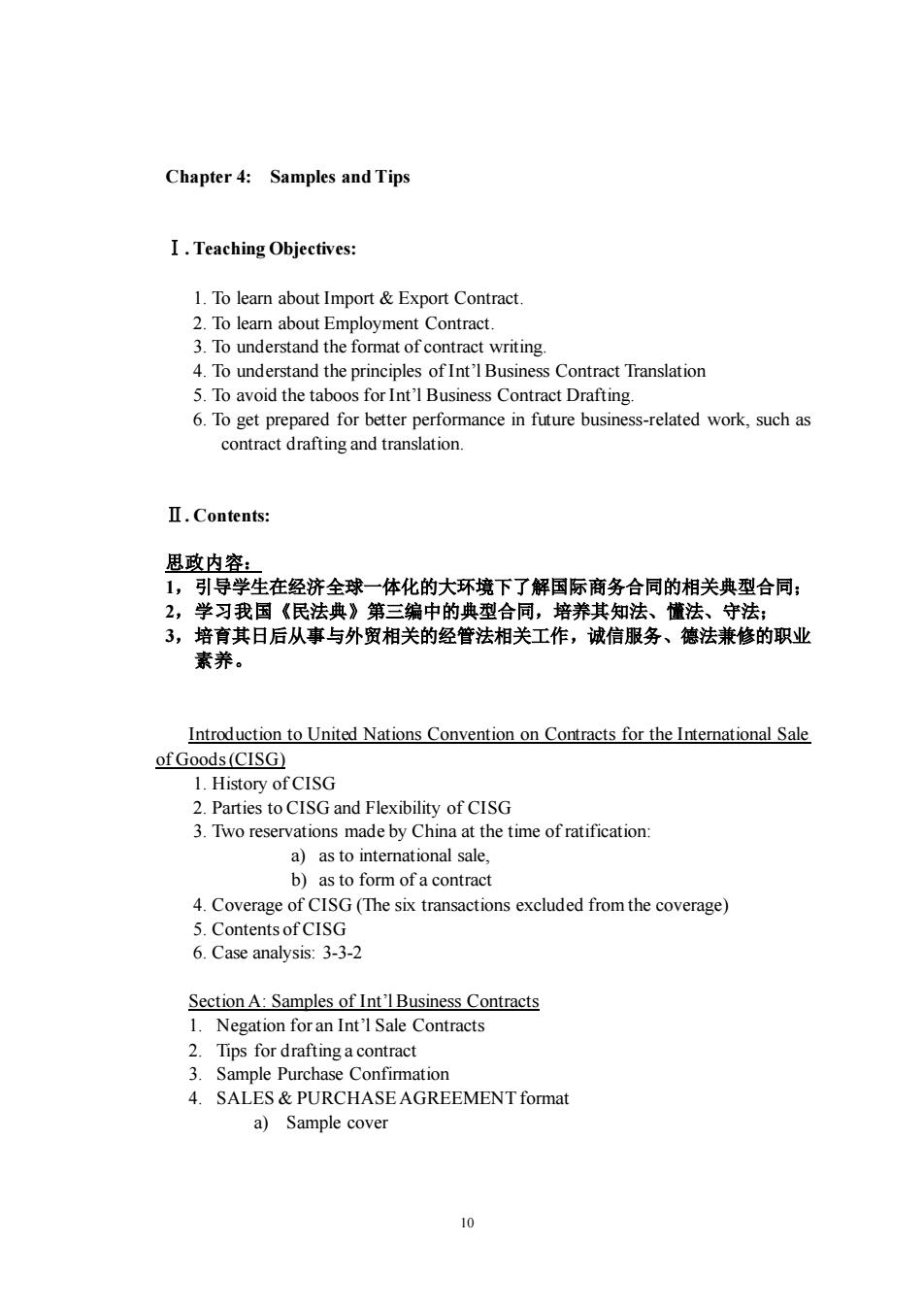
Chapter 4:Samples and Tips I.Teaching Objectives: 1.To learn about Import Export Contract. 2.To learn about Emplovment Contract. 3.To understand the format of contract writing .To understand the pri iples of Int'l Bus s Contract Translation 5.the Contract Dran 6.To get prepared for better performance in future business-related work,such as contract drafting and translation. .Contents 思政内容: 1,引导学生在经济全球一体化的大环境下了解国际商务合同的相关典型合同; 2,学习我国《民法典》第三编中的典型合同,培养其知法、懂法、守法; 3,培育其日后从事与外贸相关的经管法相关工作,诚信服务、德法兼修的职业 素 Introduction to United Nations Convention on Contracts for the International Sale of Goods(CISG) 1.History of CISG 2.Parties to CISG and Flexibility of CISG 3.Two reservations made by China at the time of ratification: a)as to international sale. b)as to form of a contract 4.Coverage of CISG(The six transactions excluded from the coverage) 5.Contents of CISG 6.Case analysis:3-3-2 Section A:Samples of Int'l Business Contracts 1.Negation foran Int'l Sale Contracts 2.Tips for drafting a contract 3.Sample Purchase Confirmation 4.SALES PURCHASEAGREEMENT format a)Sample cover 10
10 Chapter 4: Samples and Tips Ⅰ. Teaching Objectives: 1. To learn about Import & Export Contract. 2. To learn about Employment Contract. 3. To understand the format of contract writing. 4. To understand the principles of Int’l Business Contract Translation 5. To avoid the taboos for Int’l Business Contract Drafting. 6. To get prepared for better performance in future business-related work, such as contract drafting and translation. Ⅱ. Contents: 思政内容: 1,引导学生在经济全球一体化的大环境下了解国际商务合同的相关典型合同; 2,学习我国《民法典》第三编中的典型合同,培养其知法、懂法、守法; 3,培育其日后从事与外贸相关的经管法相关工作,诚信服务、德法兼修的职业 素养。 Introduction to United Nations Convention on Contracts for the International Sale of Goods (CISG) 1. History of CISG 2. Parties to CISG and Flexibility of CISG 3. Two reservations made by China at the time of ratification: a) as to international sale, b) as to form of a contract 4. Coverage of CISG (The six transactions excluded from the coverage) 5. Contents of CISG 6. Case analysis: 3-3-2 Section A: Samples of Int’l Business Contracts 1. Negation for an Int’l Sale Contracts 2. Tips for drafting a contract 3. Sample Purchase Confirmation 4. SALES & PURCHASE AGREEMENT format a) Sample cover